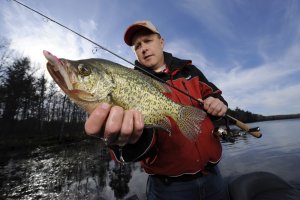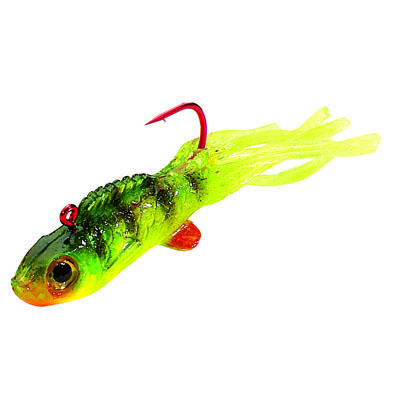
Crappies are an early-season favorite for good reason; they’re not that hard to find and readily bite. Crappies provide a great opportunity for getting the open water season underway. They are easily caught on a boat or the bank, and everybody can get in on the fun.
Most of the action involves shallow water, including black-bottom bays and channels where crappies will show up en masse and the action can be downright intense. These early runs are all about feeding and nothing more, as the actual spawn may be a month or more off. Somewhere between those first early season feeding runs and the actual spawn is a period of time when you can find big schools of the largest fish in a system holed up in specific areas.
Water temperature can be a guide to timing the hottest action. Things really get going when temps push into the lower 60s. Crappies typically spawn when water temps hold in the mid-60s, but that isn’t the only factor to consider. Consistent weather and steady water temps are the keys to finding the largest numbers of active fish up shallow. A severe cold front can shut the whole thing down (at least for the short term) and is something to be aware of.
Finding fish is job one. One approach is to locate holes or depressions near potential spawning sites. A depression is nothing more than an area that’s just a little deeper than the surrounding area and a place where crappies will stack up just before they make their move to the beds. Heavier stands of hard-stemmed bulrushes are where most of the spawning takes place, and are preferred locations as they typically provide the right bottom content and preferred cover. With that in mind, start looking for potential spawning sites and then try to find a depression in the near vicinity. If the water’s clear enough and calm enough you’ll be able to see the depression (and the fish), otherwise you’ll have to rely on electronics to do your investigating. A likely hot spot would be a pocket that’s two or three feet deeper than the surrounding shallow flat.
The real fun begins when you start trying to put a few in the boat and there are a couple of ways to get it done. Slow trolling with a Minn-Kota is preferred, as you can quietly creep along and work light jigs in the pockets and over the tops of the weeds and cover some ground until you find a concentration of active fish. Another option is dropping an anchor, as staying put may be your best bet if you’ve found a tight bunch of fish, or it’s too windy to be effective with the electric trolling motor.

A light line like four-pound test green Silver Thread along with tiny jigs including Northland Fishing Tackle’s® MIMIC MINNOW® FRY or SLURPIES®SMALL FRY suspended below a float is a tough combination to beat. A nice soft action ultra-light can add to the fun, like St. Croix’s six-foot model spinning rod. The light rod will help keep big slabs from ripping hooks lose from their super-soft mouths. When the fish are really going, the soft-plastic lures are about all you’ll need, but it doesn’t hurt to have some small minnows along for the fussier fish.
You can expect to find crappies to be found bellies-to-the-bottom to just under the surface. On calm days with some cloud cover look for fish to rise up to the point that their dorsal fins are actually breaking the surface. When this happens, try casting a SLURPIES®SMALL FRY just past the school and work it back into them. If you plop a lure right into the middle of the pack you run the risk of spooking the school.
Yes, crappies are an excellent table far. Use good judgment, though, and consider releasing some of the largest fish. Overharvesting has a detrimental effect on the population of larger fish. By using some restraint you can preserve what you’ve found for years of productive fishing.
See you on the water

